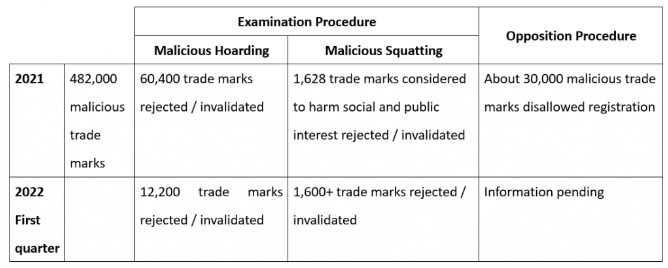- within Privacy and Corporate/Commercial Law topic(s)
- with Senior Company Executives, HR and Finance and Tax Executives
- with readers working within the Banking & Credit, Healthcare and Law Firm industries
In a recent press conference held by the China State Council Information Office, HE Zhimin, Deputy Commissioner of the China National Intellectual Property Administration (CNIPA) stated that in the last year, the CNIPA had severely cracked down upon malicious trade marks. The results of this effort by the CNIPA can be seen below:

A timeline of China's tougher stance in curbing malicious trade mark registrations in recent years
The CNIPA has been gradually introducing tougher laws on malicious trade mark practices since 2019:
1 November 2019 new China Trade Mark Law implemented
"Article 4. Any malicious trade mark registration applications that are not intended for use shall be rejected"
1 December 2019, China State Administration for Market Regulation began to implement the Rules on Regulating Trade Mark Filing Acts, specifying applicable circumstances and considerations of Article 4 of the new Trade Mark Law.
23 November 2021, CNIPA announced new Guidelines on Trade Mark Examination and Trial, refining nine applicable scenarios for Article 4 of the new Trade Mark Law, and lists typical cases for each applicable situation.
China's tougher stance on malicious trade marks in practice
Previously, trade mark squatters could easily obtain Chinese trade mark registrations which were highly similar – or even identical – to famous foreign brands. With the revision of Trade Mark Law and the enactment of new rules in China, we have seen an encouraging trend of the CNIPA and PRC court being more prepared to issue decisions with an open mind. They often cite bad faith as the ground of objection in the applications of trade mark squatters, resulting in greater protection of trade name and trade mark rights of reputable foreign brand owners in China.
Spruson & Ferguson has prevailed in an increasing number of opposition proceedings, whereby applications of similar marks for dissimilar goods filed by trade mark squatters are denied registration. Our clients have benefited from the CNIPA decisions deeming the opposed marks as having been filed in bad faith in the following typical situations:
- The opposed mark is identical to the brand owner's prior mark of certain reputation, and the opposed party applied for many other marks highly similar to the marks of other brand owners; and
- The opposed mark is virtually identical to the brand owner's prior mark, and the opposed party applied for several other marks highly similar to brand owner's artistic work.
The content of this article is intended to provide a general guide to the subject matter. Specialist advice should be sought about your specific circumstances.
[View Source]

